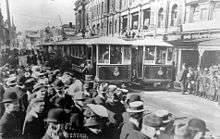Trams in Launceston
The Launceston tramway network served the city of Launceston, Tasmania in Australia from 1911 until 1952.
| Launceston tramway network | |
|---|---|
 Launceston trams in 1911 | |
| Operation | |
| Locale | Launceston, Tasmania |
| Open | 4 August 1911 |
| Close | 13 December 1952 |
| Status | Closed |
| Owner(s) | Launceston City Council |
| Operator(s) | Launceston Municipal Tramways |
| Infrastructure | |
| Track gauge | 1,067 mm (3 ft 6 in) |
| Propulsion system(s) | Electricity |
| Electrification | Overhead catenary |
| Statistics | |
| Track length (total) | 13.8 miles (maximum) |
History
Launceston Municipal Tramways, a subsidiary of the Launceston City Council, began operating on three routes on 4 August 1911 from Brisbane Street in the Launceston central business district to King's Bridge (Cataract Gorge), David Street (Newstead) and McKenzie Street (Mowbray).[1][2][3][4]
Further lines opened to Sandhill (South Launceston) on 27 October 1911, High Street (East Launceston) on 17 January 1914 and Cataract Hill (Hillside Crescent, West Launceston) on 15 May 1915. The King's Bridge line was extended to Trevallyn on 16 July 1912, and the Mowbray line to Racecourse (Mowbray Heights) on 26 January 1916.[3]
The King's Wharf line opened on 24 February 1919 to serve Bass Strait steamers. The Sandhill line was extended in 1929 to Carr Villa Cemetery. The Mowbray, Newstead and High Street lines were lengthened 1937, with the network reaching its maximum of 13.8 miles. The King's Wharf line closed in December 1947 when the steamer Taroona began berthing at Beauty Point because of the Tamar River silting. It had only operated on days ships berthed since 1932.[1][3]
The Trevallyn trams were replaced by diesel buses in March 1947, with the rest of the network gradually replaced by trolleybuses from December 1951. The Newstead line was the last closed on 13 December 1952.[1][5][6]
Rolling stock
For the commencement of operations, 14 single-truck trams were bodied locally by J&T Gunn with Brush Electrical Engineering, Loughborough supplying the trucks. By 1927 a further 12 had been delivered. In 1930 three drop centre bogie trams were bodied at the Invermay Road depot.[1][2][4]
Single-truck tram number 13 has been preserved by the Tasmanian Transport Museum[7] while bogie tram number 29 is with the Launceston Tramway Museum.[8]
Depots
The original four road depot was located on Invermay Road. After the 1929 Tasmanian floods it was relocated to the corner of Howick and Wellington Streets in 1932.[1][9] It remains in use as a Metro Tasmania bus depot.
References
- Cooper, Ian (1979). Trolley Buses of Tasmania. Sydney: Australian Electric Traction Association. pp. 46–52. ISBN 0909459053.
- Lynas, Ian (1983). Buses & Trams of Australia's Government & Municipal Operators. Waverton: Ian Lynas. p. 63. ISBN 0959258000.
- Cooper, Ian (2006). Launceston Municipal Transport 1911-1955. Rozelle: Transit Australia Publishing. ISBN 9780909459208.
- Cooper, Ian (2010). Tasmania's Trolley Buses. Rozelle: Transit Australia Publishing. pp. 117–119. ISBN 9780909459222.
- Last L'ton Tram Trip Launceston Examiner 12 December 1952 page 1
- Launceston Trams Farewelled Burnie Advocate 15 December 1952 page 1
- Tram Exhibits Tasmanian Transport Museum
- Still running…Track & Signal April 2015 page 84
- Northern Notes Hobart Mercury 11 January 1932 page 5